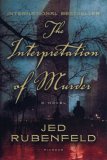Reading Guide Questions

Please be aware that this discussion guide will contain spoilers!
About this Guide
The following list of questions about
The Interpretation of Murder are
intended as resources to aid individual readers and book groups who would like
to learn more about the author and this book. We hope that this guide will
provide you a starting place for discussion, and suggest a variety of
perspectives from which you might approach
The Interpretation of Murder.
About the Book
The Interpretation of Murder opens on a hot summer night in 1909 as
Sigmund Freud disembarks in New York from a steamship. With Freud is his rival
Carl Jung; waiting for him on the docks is a young physician named Stratham
Younger, one of Freud’s most devoted American supporters. So begins this story
of what will be the great genius’s first--and last--journey to America.
The morning after his arrival, a beautiful young woman is found dead in an
apartment in one of the city’s grand new skyscrapers, The Balmoral. The next day
brings a similar crime in a townhouse on Gramercy Park. Only this time the young
heiress, Nora Acton, escapes with her life--but with no memory of the attack.
Asked to consult on the case, Dr. Younger calls on Freud to guide him through
the girl’s analysis. Their investigation, and the pursuit of the culprit, lead
throughout New York, from the luxurious ballrooms of the Waldorf-Astoria Hotel,
to the skyscrapers rising on seemingly ever street corner, to the bottom of the
East River, where laborers digging through the silt to build the foundation of
the Manhattan Bridge.
Discussion Questions
- Discuss the use of the title, The Interpretation of Murder.
- The author’s portrayal of women is noteworthy: Is Nora still a victim
when she is empowered by a sympathetic listener? What are Clara’s motives
for the events in the novel? How is Betty the maid, Susie Merrill, and
Greta depicted? Do these characters reflect the turn-of-the-century society,
or do they represent a more timeless portrayal of women?
- Dr. Stratham Younger, a thirty-three-year-old Harvard graduate who
teaches at Clark University and who is the narrator of the book, insisted at
age seventeen that all great art and scientific discoveries were made at or
near the turn of a century (Michelangelo’s David - 1501; Cervantes’s
Don Quixote - 1604; Beethoven’s symphonies - 1800; Freud’s
Interpretation of Dreams - 1900, etc.) Discuss this phenomenon.
- Is Younger the right man for the job of trying to unravel the attempted
murder of Nora? Discuss psychoanalysis versus interrogation.
- Consider the role of class conflict in the book: Jung’s feelings of
shame over his obvious wealth; Jung versus Freud; Acton versus Banwell;
Chong versus Leon; Malley and Betty, etc.
- What role does psychological transference and sexual attraction play in
the book?
- Younger asks, “How can human beings be loved if we carry within such
repugnant desires?” Freud thinks that Nora wants to sodomize her father. Is
this ultimately true?
- Discuss the author’s mix of fact and fiction. How has this device been
used in previous New York novels, such as The Alienist, Ragtime,
Dreamland: A Novel, Paradise Alley, etc.
- Younger is obsessed with solving the riddle of Hamlet in the book.
Discuss his analysis of “to be or not to be” in terms of Freudian/Oedipal
theories. What does Younger finally decide is the correct interpretation?
- Younger says, “Some people feel a need to bring about the very thing
that will most torment them.” How does this describe the characters in the
book?
- When he boards the ship back to Europe, Freud says that “America is a
mistake . . . A gigantic mistake.” What does he mean?
Unless otherwise stated, this discussion guide is reprinted with the permission of Picador.
Any page references refer to a USA edition of the book, usually the trade paperback version, and may vary in other editions.

 Book Reviewed by:
Book Reviewed by:





